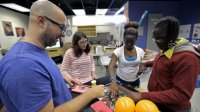Trees of Knowledge
Maybe teaching isn’t about delivering information. Maybe it’s really about providing a landscape where curiosity takes root, growing a unique, vibrant, continual source of knowledge.
Jean Piaget watched children develop very closely in the mid-20th century, and he realized that they weren't passively internalizing knowledge, like empty vessels to be filled. He proposed that people create knowledge by building mental structures, which he called schema, in a way that makes sense to them (I like to think of little imaginary "hands" building a knowledge tree). The focus on the construction of knowledge, as opposed to its transmission, led Piaget to develop the theory of constructivism.
I believe this is true, and so the question I ask myself when "teaching" people something isn't: "How can I deliver this information?" Instead, the question is: "How can I provide a landscape where curiosity will abound?" That's because this process of curiosity, and the resulting tinkering and ideation, is how you get those little "hands" inside someone's mind moving about, adding knowledge here and there, and trimming it, too. As a teacher, I want someone to be an active curator of his or her own viewpoint on the world, not a recipient of my viewpoint. Vibrant learners are sprouting new branches and growing their trees to the tune of their own heart's song.
So how can we do this? Well, the answer is kind of to change everything, but don't worry -- it's delightful. Let's start with language.
Answers and Questions
Paulo Freire (author of Pedagogy of the Oppressed) would say that his pedagogy is one of questions. So the next time someone asks you for an answer, what if you give them a question?
The question leads to more thinking and experimenting. The right answer (note this fallacy as if there is a singular answer) is what? Gravity? Wheels? Potential energy? Will these words lead to a process where the learner adds to his or her tree of knowledge internally? What about a question?
This sets someone off running, and that tree starts growing. And it's not just the questions you ask. In fact, it's any statement that makes that internal tree of knowledge grow.
By saying, "I wonder," we are modeling a sense of curiosity ourselves.
That answer is lifted directly from the title of a book by Eleanor Duckworth, a student of Piaget and Inhelder. When one says, "Tell me more," one is indirectly saying, "I think your ideas are wonderful, keep on having them!"
The Purpose of Your World
What else besides language?
What about architecture? Instead of stages with lectures, how about stations with hands-on, open-ended activities?
What about rewards? Instead of tests and report cards, how about exhibitions and portfolios?
What about tools? I design tools not to provide a function. My tools, Drawdio, Makey Makey, etc. are interrogative -- they ask a question.
- Will your webcam be triggered by a fist bump, or when a door slams, or what?
- Will you clip your alligator clips onto bananas or some other object in the world, and how will that change the meaning of your computer?
- What should the purpose of your surrounding world be?
Those questions are inherent to the support materials and tool design that come embedded in my tools.
Stations, portfolios, interrogative tools, and questions are all just different forms of the same thing: stimulating a human's own growth process, getting their "internal hands" moving all about their own unique tree of knowledge.
I have even seen examples in my day of someone who grows a fake tree of knowledge alongside their true tree, to help regurgitate answers that have been fed to them. But scientists who make lifesaving breakthroughs don't use their fake trees. Artists who push their medium to make others stand with mouth agape don't access textbook knowledge. They make their breakthroughs from their true trees of knowledge that they have passionately curated, and the roots grow down into their hearts.
Let's nurture and encourage each human's own growth process by providing a healthy environment with plenty of intellectual minerals in the soil. Next time I engage with any learner, I will ask myself, "How can my interaction lead to more questions, more self-direction, more curiosity?" And as for the "right answer," it's junk food. It tastes good in the short term, but the tree may never fruit.
Roots of My Tree
- My advisor Mitch Resnick taught me about the power of kindergarten (which directly translates to "child garden") as a metaphor.
- Makey Makey was co-invented with Eric Rosenbaum.
- Romie Littrell co-facilitated the workshop depicted in the video, which was filmed at the Cade Museum.
